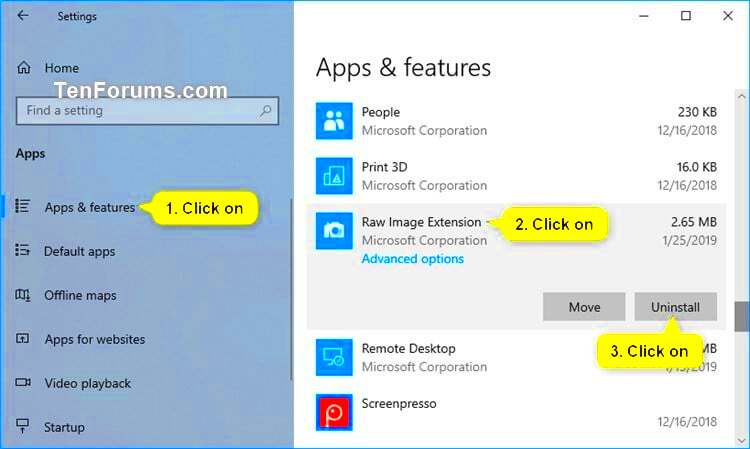As of most recently October 2023, one of the few untouchable variables in photographic imaging systems is the raw image extension. This file format allows for photographs having more levels of detail than any other standard file extension like JPEG or PNG. These files contain unprocessed data straight from the camera’s sensor which gives you greater control over editing process. The most common raw picture formats include .CR2 (Canon), .NEF (Nikon) and .ARW (Sony) among others; they are big hence they may not work on all software programs yet they are great to use by professionals worldwide even if large. It is important for everyone who has ever worked with photography or digital art to know about raw picture extensions.
Identifying the Need to Uninstall
In case it’s causing some problems with the software programs you are using, it would be advisable that you remove any image raw extensions from your computer. Here are several situations commonly associated with this need:
- Compatibility Issues: If your software does not support raw files, you may want to remove the extensions.
- Storage Space: Raw files take up a lot of space, and uninstalling the extensions can free up valuable memory.
- Performance Problems: Sometimes, having too many extensions can slow down your system.
- Preference for Other Formats: If you prefer working with JPEG or PNG, uninstalling raw extensions can simplify your workflow.
A clear awareness of these needs will enable you to make an informed choice on whether to remove it from your device or not.
Also Read This: how to release vector from adobe stock photos
Checking Installed Raw Image Extensions
You should check what raw image extensions are on your device before moving forward with uninstallation. Here’s how:
- Open the Settings on your computer.
- Navigate to Apps or Programs.
- Look for Installed Apps or Features.
- Scroll through the list to find any raw image extensions. They might be listed under their specific names, such as Raw Image Extension, or under the software you use for photography.
Dump the unused raw photo formats for more space or free up some space by removing it completely.
Also Read This: A Step by Step Guide on How to Download Shutterstock Images for Free Without Watermark
Steps to Uninstall Raw Image Extensions
Taking away unrefined picture extensions from your machine is a simple task. You can follow the easy methods below even when using Windows or Mac OS to remove unnecessary extensions. Here’s a short guide that will direct you through:
- Access Settings: For Windows, click on the Start menu and select Settings. For macOS, open System Preferences.
- Navigate to Apps: In Windows, click on Apps and then Apps & Features. On macOS, look for Applications.
- Find Raw Image Extensions: Scroll through the list to find any installed raw image extensions, like Raw Image Extension or the name of the software you’re using.
- Select and Uninstall: Click on the extension to highlight it, then select Uninstall (Windows) or drag it to the Trash (macOS).
- Follow Prompts: Confirm any prompts that appear to finalize the uninstallation process.
Once these moves are carried out, there will no longer be raw picture extensions on your machine which will create extra space and increase compatibility with file format of choice.
Also Read This: Famous Car Companies Across the USA Captured in Images
Common Issues During Uninstallation
Although uninstalling raw image extensions is often easy, there might be some inconveniences that you will come across. Below are some of the frequent problems plus ways to solve these problems:
- Extension Not Found: If you can't find the extension in the list, it might not be installed. Ensure you are looking in the correct location.
- Error Messages: Sometimes, you may see error messages during uninstallation. This could be due to permissions; try running the uninstaller as an administrator.
- Software Dependency: If other software relies on the raw image extension, the uninstallation may fail. Make sure to close any applications using the extension.
- Incomplete Uninstallation: If the extension appears to still be present, try rebooting your computer and check again.
Knowing about these issues can enhance the uninstallation procedure.
Also Read This: A Top List of Linkedin Graphic Designer Jobs
Verifying Successful Uninstallation
The process of confirming if the raw image extensions were uninstalled successfully is necessary after their removal. The steps to follow are provided below:
- Open Settings: Return to the Settings menu on your computer.
- Check Installed Apps: Navigate back to the Apps or Applications section and review the list again.
- Look for Extensions: Make sure the raw image extensions you intended to uninstall are no longer listed.
- Test File Compatibility: Try opening a raw image file to see if the system prompts you to install the extension again. If it does, the uninstallation may not have been successful.
The following steps will help you make sure that your uninstallation was accomplished successfully and that your device remains free of any unnecessary raw image file contractors.
Also Read This: how to change bit depth of image
Alternative Solutions for Raw Images
It is important to note that we are limited to data available until October 2023. You can take advantage of the numerous alternative solutions if you have come to the conclusion that working with raw image extensions is not for you. Keeping quality intact becomes easier without using complex raw formats when handling images in another way. Some alternatives include:
- Use JPEG or PNG Formats: These formats are widely supported and suitable for most purposes. They offer decent quality while being smaller in size. Just keep in mind that they are lossy formats, meaning some image quality is sacrificed during compression.
- Convert Raw Files: If you have existing raw files, consider converting them to more common formats. Software like Adobe Lightroom, Capture One, or even free tools like GIMP can do this for you.
- Utilize Cloud Services: Cloud storage platforms such as Google Drive or Dropbox allow you to store and manage your images without taking up local space. Many of these services also support viewing and sharing various image formats.
- Edit Using Software: Many editing software options can handle raw images without needing the raw extensions installed. Programs like Adobe Photoshop or PaintShop Pro can often read raw files directly, giving you the ability to work with them seamlessly.
While ensuring great quality, these alternatives can make your workflow less complicated and manage your images even better.
Also Read This: Cropping Multiple Images at Once for Batch Editing
FAQs About Raw Image Extensions
There are many questions on the management of raw image file extensions and that most people raise. Therefore, below are Frequently Asked Questions that should help clarify all your ambiguities:
| Question | Answer |
|---|---|
| What are raw image extensions? | Raw image extensions are file formats that store unprocessed data from a camera sensor, providing more detail and flexibility for editing. |
| Why should I uninstall raw image extensions? | You might want to uninstall them for compatibility issues, to save storage space, or if you prefer working with more common file formats. |
| Can I recover uninstalled raw extensions? | Yes, you can reinstall raw image extensions from the official Microsoft Store or the respective software website. |
| What software supports raw images? | Software like Adobe Lightroom, Capture One, and GIMP supports various raw formats, allowing for editing without extensions. |
With these responses, you can face your path of native representatives of pictorial information with self-assurance.
Conclusion on Managing Raw Image Extensions
Handling raw image extensions need not be a big deal. If you understand what they are and their downsides, you can choose wisely when managing your photographs. Consider instead using JPEGs or converting from the current RAW format or storing in a cloud service depending on which way suits your workflow. Always verify that uninstallation was successful and that you know how to edit and manage images. If approached correctly, digital photography becomes easier and then the photographer can devote more time on taking attractive photos.

 admin
admin








